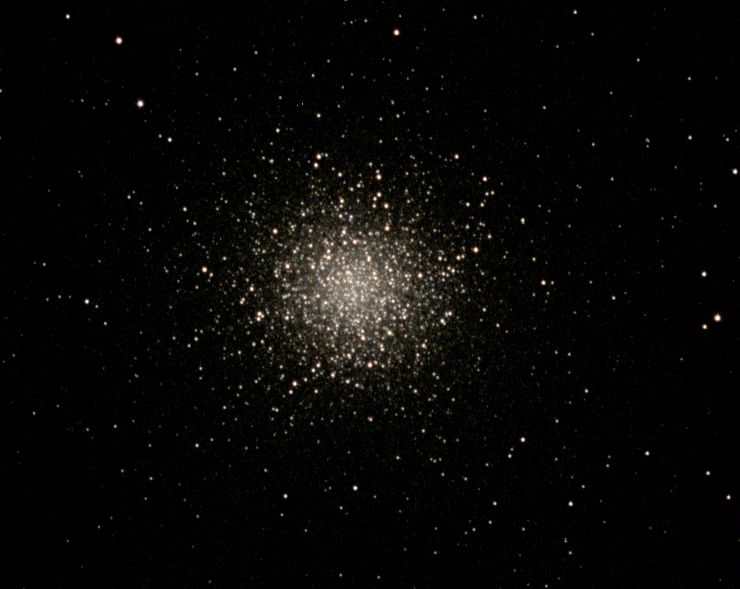
The globular star cluster M13 in Hercules is about 25,000 to 30,000 light years from Earth. The Sun's motion in space, the rotation of the Milky Way galaxy, and the revolution of the cluster around the center of our galaxy brings the cluster 150 miles closer every second. Nevertheless, even at that rate it will take many, many years before we have to start putting on extra suntan lotion when we go outside.
The cluster is home to more than 100,000 stars. Some astronomers estimate the total number of stars in the cluster at one million. It is approximately 150 to 160 light years in diameter. This colossal assemblage of stars is over 12 billion years old. Images of the cluster give the impression that stars in the center of the cluster are crowded together virtually in contact. This is an illusion caused by the innumerable star images that, at this vast distance, seem to merge together. According to Burnham's Celestial Handbook, in a scale model of the star cluster where the stars are the size of a grain of sand, even in the closely packed center of the cluster the grains of sand would be separated from each other by the greater part of a mile. In such a scale model, the million grains of sand representing the stars of the cluster would be distributed in a spherical volume of space about 300 miles in diameter.
Burnham's Celestial Handbook gives a description of what it would be like to live on a planet in the center of the cluster. The appearance of the heavens from such a planet would be quite a spectacle. The heavens would be filled with uncountable numbers of blazing stars which would dwarf our own Sirius and Canopus to insignificance. Many thousands of stars ranging in brilliance between Venus and the full moon would be continually visible, so there would be no real night at all. Inhabitants of such a planet would know little of the other splendors of the universe, because they would not be able to see them!
Could one of these stars have a solar system that harbors intelligent life? At the 1974 dedication of Arecibo Observatory, a radio message about Earth was sent into space in the direction of M13. Although the message is traveling at the speed of light, it will take more than 25,000 years to reach anyone who may be living on a planet in the cluster. So it may be a while before we receive a reply.
This star cluster was added as object number 13 on the Messier List.
This is a CCD image taken with an SBIG ST-8 CCD and a Takahashi FS-128 refractor. A Homeyer color filter wheel was used to take tri-color images using red, green and blue filters. The images were processed using MaxIm DL.
M13 (NGC 6205)
Constellation: Hercules
RA:16h 41m 37.7s Dec:+36d 28' 22"
September 28, 1998
Image by Sid Leach
Iola, Texas
Recent Images.
Complete list of images.
Description of equipment used to acquire images.
Home
Feedback and comments should go to Sid